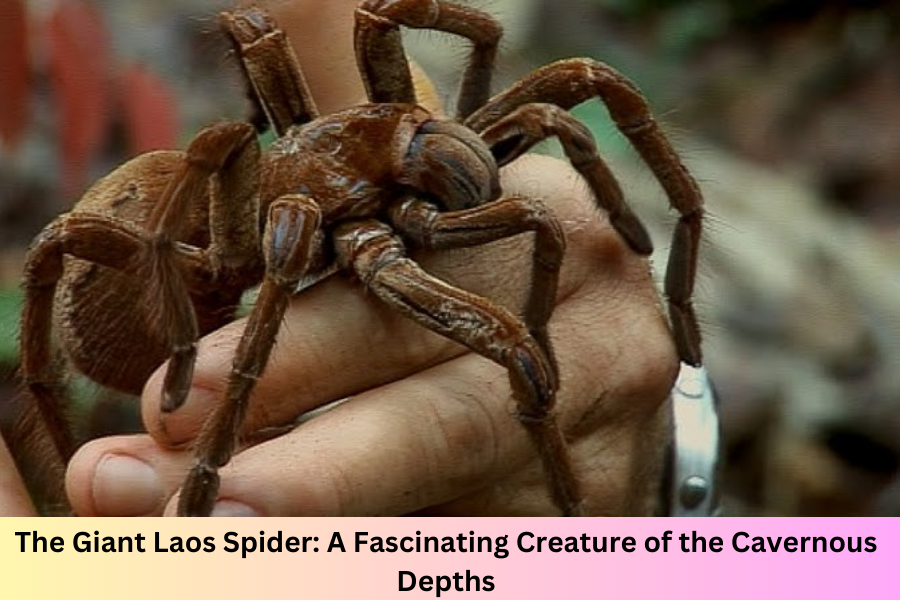Introduction
The Giant Huntsman Spider, scientifically known as Heteropoda maxima, is one of the most impressive arachnids on the planet. It holds the title of the largest spider by leg span, with its remarkable legs reaching up to 12 inches (30 cm) across. Discovered in the dark caves of Laos, this spider has sparked curiosity and fascination due to its extraordinary size and its adaptation to cave life.
Discovery and Habitat
The Giant Huntsman Spider was first discovered in 2001 by a team of scientists exploring the caves of Laos. Found primarily in the limestone karst formations of northern Laos, this spider’s habitat is quite unique. Unlike most spiders that live in the open, the Giant Huntsman has adapted to cave environments that are dark, humid, and often isolated.
Caves provide the perfect ecosystem for this arachnid, offering a stable environment with minimal temperature fluctuation. The humid conditions are essential for its survival, aiding in hydration and supporting its molting process. The caves are also rich in prey, with a variety of insects and smaller invertebrates providing a consistent food source. Additionally, the caves offer protection from predators, allowing the Huntsman Spider to thrive without significant threats.
These spiders are typically found in crevices and rocky formations within caves. Their preference for these secluded spots helps them avoid larger predators, and it’s within these nooks that they build their small, hidden lairs.
Physical Characteristics
The most striking feature of the Giant Huntsman Spider is its size. While its body length may range from 2 to 3 inches (5 to 8 cm), its leg span can reach up to 12 inches (30 cm). This makes it one of the largest spiders by leg span in the world. The spider’s legs are long, thin, and covered in fine hairs, allowing it to traverse rocky and uneven surfaces with remarkable agility.
Its body is relatively flat, another adaptation that makes it more suited to its cave-dwelling lifestyle. This flatness allows the spider to squeeze into tight crevices, where it can wait patiently for its prey. The spider’s color ranges from light brown to pale yellow, helping it blend into its rocky cave surroundings. The pigmentation also contributes to its camouflage, allowing it to stay hidden from both potential prey and larger predators.
Wiki
| Attribute | Details |
| Common Name | Giant Laos Spider (Huntsman Spider) |
| Scientific Name | Heteropoda maxima |
| Size | Leg span up to 12 inches (30 cm); body length 2 to 3 inches (5 to 8 cm) |
| Habitat | Limestone caves in northern Laos, typically in humid, dark, and isolated environments |
| Diet | Insects, small invertebrates, and small vertebrates like lizards and rodents |
| Venom | Potent enough to immobilize prey; not harmful to humans, but may cause mild pain and swelling |
| Hunting Method | Hunts by chasing prey and using speed and venom to immobilize |
| Behavior | Nocturnal, prefers to avoid human contact; uses its flat body and long legs to navigate caves |
| Conservation Status | Not endangered, but threatened by habitat destruction due to human activities like limestone quarrying |
| Discovery | First discovered in 2001 in Laos by a team of scientists |
| Adaptations | Flat body and long legs help in navigating cave terrain; sensitive to vibrations for prey detection |
Behavior and Hunting Techniques
Unlike many other spiders, the Giant Huntsman Spider does not rely on a web to capture prey. Instead, it is a fast, agile hunter. Known for its ability to sprint across cave floors, the Giant Huntsman uses its speed to chase down insects, small vertebrates, and other invertebrates. This hunting style is more characteristic of hunting spiders like the wolf spider than traditional web-building arachnids.
The spider’s movement is incredibly swift, with it often darting from one crevice to another in search of food. Its long legs and flat body make it highly efficient in navigating the uneven and often treacherous terrain of caves. This ability to swiftly chase down prey allows the Huntsman Spider to catch faster-moving insects that may elude other types of spiders.
Since the spider hunts rather than waits, it has developed keen sensory abilities to detect prey. It uses its legs, which are sensitive to vibrations, to sense movement from insects or small animals nearby. Once prey is detected, the spider can quickly lunge forward to capture it.
Diet and Venom
The diet of the Giant Huntsman Spider primarily consists of insects and small invertebrates. However, it is also known to prey on small vertebrates such as lizards and rodents. The spider’s venom is used to immobilize its prey. When the spider bites its prey, it injects venom that paralyzes the victim, allowing the spider to consume it more easily. While the venom of the Giant Huntsman is potent enough to subdue its prey, it is not typically harmful to humans. A bite from this spider may result in mild symptoms such as localized pain, redness, and swelling. However, it is unlikely to cause any serious medical issues unless the individual is allergic to spider venom.
The venom works by disrupting the prey’s nervous system, causing paralysis and eventually death. Once the prey is immobilized, the Huntsman Spider uses its powerful jaws to pierce the exoskeleton and begin feeding. This method of hunting, which involves overpowering prey with speed and venom, is what makes the Huntsman Spider a fearsome predator in its cave environment.
Adaptations for Cave Life
The Giant Huntsman Spider has several adaptations that enable it to survive in the dark, humid caves of Laos. One of the key adaptations is its flat body. This physical feature allows the spider to fit into narrow crevices, which is essential for hunting and hiding. In addition to its body shape, the spider’s long legs help it maneuver over the uneven surfaces of the cave floor with great speed.
Caves are environments where light is scarce, and the Giant Huntsman Spider has evolved to thrive in these low-light conditions. It is a nocturnal creature, meaning it hunts during the night when the caves are completely dark. The absence of light provides the spider with an advantage in catching prey and avoiding larger predators.
Another important adaptation is its ability to survive in the high humidity levels of caves. Humidity plays a crucial role in the spider’s survival by keeping its body hydrated and aiding in the molting process. The spider’s exoskeleton is periodically shed as it grows, and the humid environment of the caves provides the necessary conditions for this vital process.
The Role in the Ecosystem
As a predator, the Giant Huntsman Spider plays an important role in its cave ecosystem. It helps control populations of insects and other small animals that would otherwise grow out of control. By keeping the insect population in check, the spider helps maintain balance within the cave environment.
Its presence in the caves of Laos also highlights the importance of these unique ecosystems. The caves offer shelter to numerous species of plants and animals that have adapted to this specialized environment. The discovery of the Giant Huntsman Spider and other similar species has deepened our understanding of cave biodiversity and the remarkable adaptations that occur in isolated ecosystems.
Venom and Its Effect on Humans
While the venom of the Giant Huntsman Spider is not considered dangerous to humans, it is potent enough to incapacitate small prey. The venom works by attacking the nervous system, which is essential for subduing its food. The venom can cause localized pain, redness, and swelling at the site of a bite, but these symptoms generally subside within a few hours to a few days. There is no significant long-term damage from a bite, and severe reactions are rare.
However, due to its size and aggressive hunting behavior, the Giant Huntsman Spider has gained a reputation as a “scary” creature. It is essential to note that despite its appearance, the spider is not typically a threat to humans unless provoked. It is far more likely to flee when encountering humans than to attack unless it feels cornered or threatened.
Conservation Status
While the Giant Huntsman Spider has not been classified as endangered, its habitat faces threats from human activities. Limestone quarrying and cave tourism have led to habitat destruction in some areas, putting the spider and other cave-dwelling species at risk. Conservation efforts are needed to protect these fragile ecosystems and ensure the survival of unique species like the Giant Huntsman.
Efforts to preserve the caves of Laos are essential not just for the survival of the Giant Huntsman Spider, but for many other species that inhabit these ecosystems. Protecting the caves also helps preserve the delicate balance of these environments, which are often home to undiscovered species of plants and animals.
Cultural Fascination and Scientific Interest
The discovery of the Giant Huntsman Spider has generated significant interest among scientists and nature enthusiasts alike. Arachnologists have studied the spider to learn more about its behavior, adaptations, and ecological role. The spider’s massive size and distinctive characteristics make it a subject of fascination, and it has even made appearances in various media outlets and documentaries.
In addition to its appeal to arachnologists, the Giant Huntsman Spider has become a symbol of the hidden wonders of the natural world. Its discovery underscores the value of scientific exploration and the importance of preserving natural habitats, especially those that are unique and fragile like caves.
This spider remains a subject of ongoing research, and with every new discovery, scientists gain a deeper understanding of the world’s diverse ecosystems and the remarkable creatures that inhabit them.
Conclusion
The Giant Laos Spider, scientifically known as Heteropoda maxima, is a remarkable arachnid that stands out not only for its colossal size but also for its adaptations to a unique cave-dwelling lifestyle. Native to the limestone caves of Laos, this spider’s massive leg span and efficient hunting abilities make it a fearsome predator in its environment. With a diet consisting of insects, small invertebrates, and even small vertebrates, it plays an important role in controlling populations within its cave ecosystem. Its behavior, size, and specialized features have drawn significant attention from scientists and arachnologists, making it a symbol of the fascinating biodiversity hidden within the world’s cave systems.
While the Giant Huntsman Spider is not dangerous to humans, its venom is potent enough to incapacitate its prey. Despite its intimidating appearance, this spider prefers to avoid human interaction. The conservation of its unique cave habitat is essential to ensure the survival of this species, as human activities such as limestone quarrying and cave tourism threaten these fragile environments. As research continues and awareness grows, it’s important to protect the habitats of the Giant Laos Spider to safeguard not only this extraordinary creature but the rich ecosystems in which it thrives.
FAQs
1. What is the size of the Giant Laos Spider?
The Giant Laos Spider, also known as the Giant Huntsman Spider, has a leg span of up to 12 inches (30 cm), making it one of the largest spiders by leg span in the world. Despite its large size, its body length is only about 2 to 3 inches (5 to 8 cm).
2. Where can you find the Giant Laos Spider?
The Giant Laos Spider is native to the limestone caves of Laos. It prefers dark, humid, and isolated environments where it can hunt for prey and avoid larger predators.
3. Is the Giant Laos Spider dangerous to humans?
Despite its large size and fearsome appearance, the Giant Laos Spider is not dangerous to humans. Its venom, though effective at paralyzing prey, is not harmful to humans. A bite may cause mild pain, redness, and swelling but is generally not serious.
4. What does the Giant Laos Spider eat?
The Giant Laos Spider primarily preys on insects and small invertebrates. It may also consume small vertebrates like lizards and rodents. It hunts by chasing down its prey, using its speed and venom to immobilize and subdue it.
5. How does the Giant Laos Spider adapt to cave life?
The Giant Laos Spider has adapted to cave life with a variety of unique features. Its flat body and long legs allow it to navigate the rocky and uneven surfaces of caves with ease. It is also nocturnal, hunting during the night in the absence of light. The humid conditions of caves support its molting process and hydration needs.
6. Is the Giant Laos Spider endangered?
While not currently classified as endangered, the habitat of the Giant Laos Spider is at risk due to human activities such as limestone quarrying and cave tourism. Conservation efforts are essential to protect these delicate ecosystems and the species that rely on them.
7. Why is the Giant Laos Spider important to its ecosystem?
The Giant Laos Spider plays a crucial role in maintaining balance within its cave ecosystem. By preying on insects and small animals, it helps control their populations and prevents overpopulation. This contributes to the health and stability of the cave environment.
Explore the latest news and updates on Play Hop



